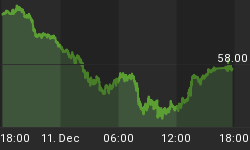By the editors of BIG GOLD
All the hot air emanating from the participants of the just concluded G20 Summit in London has, with the help of the breathless press, made its way into our neighborhood and lifted the Gordon Brown Alert wind sock atop the Casey Research headquarters.
A little background: Gordon Brown, Britain's prime minister, became infamous for his, let's say, slightly off judgment when he was still serving as chancellor of the Exchequer. Between 1999 and 2002, Brown managed to sell 400 tons or 60% of the country's gold at the very bottom of gold's 20-year bear market. The average price per ounce achieved at the 17 gold auctions was $275 - costing British taxpayers around $2.96 billion. This stroke of genius earned the chancellor such sterling titles as "Sold The Gold Brown" and "Bottom Brown," among others that don't meet our PG rating for publishing.
Incidentally, 2002 was also the breakout year for gold and the beginning of our current bull market for the metal.
A similar event in the bluster-sphere had the Alert sock flopping around again in early 2005. In February of that year, Brown was making the rounds on the press release circuit calling for a "revaluation" of the IMF's gold - that's code for "sell the barbarous relic."
Gold was selling for around $415/oz at the time - and within months, the second leg of gold's bull run began. On May 11, 2006, gold peaked at an intraday high of $725 and remained in the $600 to $700 range for over a year in a consolidation that led to another sharp advance.
In January 2007, the IMF's gold was again in the spotlight. A committee was formed to advise the IMF Executive Board how to solve the organization's funding needs, and selling some of the IMF's gold was part of the committee's recommendations.
And we had something to say about it.
The following is from an article titled "About Those Proposed IMF Gold Sales" by BIG GOLD editor Doug Hornig, with an introductory comment by Casey Research Chairman Doug Casey:
As you have probably heard by now, a blue-ribbon panel recently advised the IMF to sell gold as a way of trying to clean up its finances.
The news initially spooked some weaker holders and hedge fund managers, most of whom are clueless about the overarching trends driving gold. However, as Doug Hornig makes clear in the following report, the proposed IMF sales represent much ado about nothing... other than perhaps creating a buying opportunity, that is.
Doug Casey
Doug Hornig concluded his article with:
Even if a sale does come about, will it matter?
Many feel that the IMF's actions are not liable to have much impact on gold, arguing that the distortions of the CBGA, even at maximum 500-ton strength, have already been fully factored into the current price and its trend line.
This is not to say that there couldn't be a short-term downdraught. Sure there could be, especially as the IMF sales are formally announced. Some holders of gold, maybe a significant number, can be expected to sell into the news.
But with countries such as China, Russia and the nations of the Middle East itching to add to their reserves, even a large dump of physical metal onto the market is certain to be absorbed in short order.
Nor will countries be the only buyers. Beverly Hills investments manager Kenneth Gerbino wrote in 2005 about a similar IMF sales speculation, saying that any additional supply "would surely be snapped up by the bullion banks and mining companies that are 'short' somewhere between 10,000 and 12,000 tonnes, according to some very savvy analysts." There's no reason to think that's changed much in the interim.
Gerbino could have been writing about the IMF when he concluded, "Central bankers will most likely continue, as usual, to scare the price of gold down from time to time by statements of gold sales. But they are all too keenly aware of the growing number of people who realize that the gold, not paper and ink, is the real stable monetary element."
Finally, it is important to keep the relatively miniscule amount of gold sales we are talking about in perspective. In an era where over $1 trillion in derivatives trade globally each day, $6.6 billion in sales is just not that much money when compared to potential investor demand once the U.S. dollar goes into the free fall that Doug Casey, among others, now believe is imminent.
In other words, if IMF sales do happen, and if they depress gold's price, that's a buying opportunity... for bullion and especially for the high-quality junior exploration stocks that pack the most punch in a rising gold market.
This insight is as valid today as it was in 2007, to which we'll add that gold embarked on its third major up-leg of this bull market the following August, exploding from $650 to $1,000 in just seven months.
Fast forward to April 2009, and Goldfinger Brown is at it again, campaigning for IMF gold sales. What does it mean? Will he prove once again to be a contrarian indicator? We don't know. But it doesn't take a two-by-four to get our attention. In the meantime, we'll keep an eye on the old Alert sock.
***
We at Casey Research don't try to "time" the market, but we do pay close attention to any factors that could sway it one way or the other. Whether Brown's antics indicate the next leg up in the gold bull market or not, gold is bound to go higher during the global economic meltdown. At this point, we recommend having 33% of your portfolio in physical gold... and crisis-proof, gold-related investments that can get you up to 4 times the return of the metal itself. Click here to learn more.
















